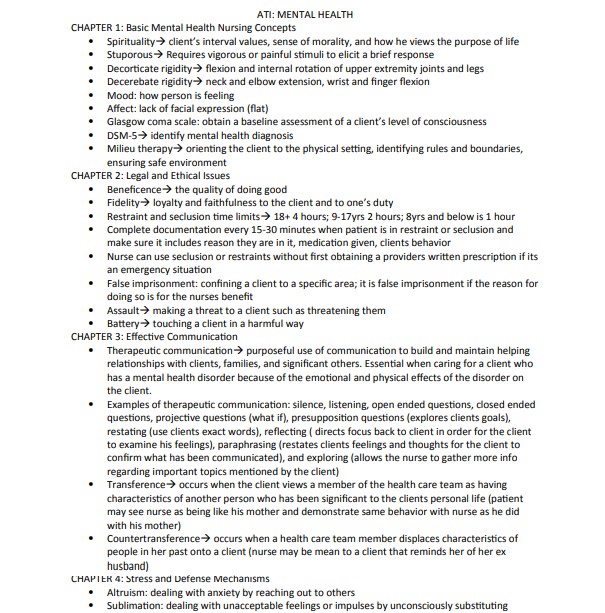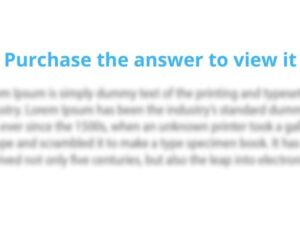Ati Mental Health Nursing Care (NURS 340)
- Description
- Full Document

Wichita State University
Mental Health Nursing Care (NURS 340)
ATI: MENTAL HEALTH
CHAPTER 1: Basic Mental Health Nursing Concepts
Spirituality client’s interval values, sense of morality, and how he views the purpose of life
Stuporous Requires vigorous or painful stimuli to elicit a brief response
Decorticate rigidity flexion and internal rotation of upper extremity joints and legs
Decerebate rigidity neck and elbow extension, wrist and finger flexion
Mood: how person is feeling
Affect: lack of facial expression (flat)
Glasgow coma scale: obtain a baseline assessment of a client’s level of consciousness
DSM-5 identify mental health diagnosis
Milieu therapy orienting the client to the physical setting, identifying rules and boundaries,
ensuring safe environment
CHAPTER 2: Legal and Ethical Issues
Beneficence the quality of doing good
Fidelity loyalty and faithfulness to the client and to one’s duty
Restraint and seclusion time limits 18+ 4 hours; 9-17yrs 2 hours; 8yrs and below is 1 hour
Complete documentation every 15-30 minutes when patient is in restraint or seclusion and
make sure it includes reason they are in it, medication given, clients behavior
Nurse can use seclusion or restraints without first obtaining a providers written prescription if its
an emergency situation
False imprisonment: confining a client to a specific area; it is false imprisonment if the reason for
doing so is for the nurses benefit
Assault making a threat to a client such as threatening them
Battery touching a client in a harmful way
CHAPTER 3: Effective Communication
Therapeutic communication purposeful use of communication to build and maintain helping
relationships with clients, families, and significant others. Essential when caring for a client who
has a mental health disorder because of the emotional and physical effects of the disorder on
the client.
Examples of therapeutic communication: silence, listening, open ended questions, closed ended
questions, projective questions (what if), presupposition questions (explores clients goals),
restating (use clients exact words), reflecting ( directs focus back to client in order for the client
to examine his feelings), paraphrasing (restates clients feelings and thoughts for the client to
confirm what has been communicated), and exploring (allows the nurse to gather more info
regarding important topics mentioned by the client)
Transference occurs when the client views a member of the health care team as having
characteristics of another person who has been significant to the clients personal life (patient
may see nurse as being like his mother and demonstrate same behavior with nurse as he did
with his mother)
Countertransference occurs when a health care team member displaces characteristics of
people in her past onto a client (nurse may be mean to a client that reminds her of her ex
husband)
CHAPTER 4: Stress and Defense Mechanisms
Altruism: dealing with anxiety by reaching out to others
Sublimation: dealing with unacceptable feelings or impulses by unconsciously substituting
acceptable forms of expression
Suppression: keep back feelings (student puts off thinking about a fight she had with her friend
so she can focus on a test)
PREVIEW

NOTE: Please check the details before purchasing the document.

